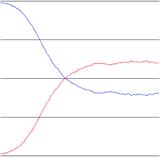博文
两个博弈问题
|
Snowdrift game 和 Prisoner's dilemma game
达尔文的进化论提出以后,从生物学上解释为什么物种中还依然存在着广泛的合作(cooperation)就成了一个长期困扰生物学家的问题。物理学家在“囚徒困境”(Prisoner's dilemma game)的基础上给出的解释,认为有大概29%的合作行为,但是这远低于实际中发生的情况,进而,从“铲雪堆博弈”(Snowdrift game)中给出了可以高达49%的合作。“铲雪堆博弈”又称“鹰鸽博弈”(Hawk-Dove game),Nature上有篇“第一性原理”(The first princple)采用鹰鸽博弈解释合作行为的文章。
下面是从http://www.univie.ac.at/virtuallabs/Introduction/sd.html上找到的关于sonowdrift game的介绍。
========================================================================================
Introduction:
Snowdrift game
by Christoph Hauert, Version 1.1, September 2005.
The Snowdrift game (or Hawk-Dove game, a more common name for behavioral ecologists or Chicken often used in economics or political sciences, but both lacking the interpretation in terms of cooperation) represents another metaphor for cooperative interactions as illustrated by the following anecdote:
Imagine two drivers on their way home that are caught in a blizzard and trapped on either side of a snowdrift. Each driver has the option to get out and start shovelling or to remain in the cozy warmth of the car. If both start shovelling each has the benefit of getting home while sharing the labour costs. However, if only one shovels both drivers still get home but the lazy bum avoids the labour costs. Nevertheless and despite the shovelling, the benefit of getting home outweighs the awkward prospects of waiting for spring to melt the obstacle.
What should each driver do? In contrast to the Prisoner's Dilemma the best action (from a rational perspective bare of any social components) now depends on the other drivers behavior: remain in the car (defect) if the other shovels (cooperate) but shovel if the other remains in the car. Probably the most famous appearance of the Chicken game occurred in the motion picture Rebel Without a Cause where James Dean and Buzz race in an amazing showdown towards a cliff.
|
Table 2: Payoff matrix for the Snowdrift game. Payoffs are indicated for the column player. |
|||||||||||||||||||||||||||||||
|
A. The only formal difference between the Snowdrift game and the Prisoner's Dilemma refers to the ranking of the payoff values: T > R > S > P (remember, in the Prisoner's Dilemma it was T > R > P > S). This results in two Nash equilibria with CD and DC. |
B. More intuitively, assume that the benefit of getting home is b while the total labour costs to remove the snowdrift are c with b > c > 0. (For high costs, 2 b > c > b > 0, these payoffs recover the Prisoner's Dilemma.) |
||||||||||||||||||||||||||||||
|
|
||||||||||||||||||||||||||||||
This apparently small change in the ranking of the payoff values (see Table 2.A) changes the situation fundamentally and leads to persistence of cooperative behavior. More precisely, cooperators and defectors co-exist even in well-mixed populations.
In field and experimental studies it is often difficult to assess the fitness payoffs for different behavioral patterns, and even the proper ranking of the payoffs is challenging. This has led to a considerable gap between theory and experimental evidence, and to an increasing discomfort with the Prisoner’s Dilemma as the only model to discuss cooperative behavior. The Snowdrift game is a viable and biologically interesting alternative. It occurs whenever not only the recipient but also the cooperator draws some benefit from the act of cooperation. For example, foraging yeast cells secrete an enzyme to lyse their environment. The resulting food resource is vital for the survival of the cells, but it also represents a common resource that is prone to exploitation by cheaters avoiding the costly production of the enzyme. If a cell cannot exploit food resources provided by others it is better off producing the vital but costly enzyme despite the risk of being exploited by others.
Further information on the Snowdrift game is provided in a separate interactive tutorial on effects of population structures in the Prisoner's Dilemma as compared to the Snowdrift game. In addition, another tutorial on a variant, the Continuous Snowdrift game, is also available. The latter provides an intriguing theoretical explanation for the evolutionary origin of cooperators and defectors (Doebeli, M., Hauert, C. & Killinback, T. Science 2004).
Examples
Example 3
|
The Snowdrift game in well-mixed populations.
|
|||
Well-mixed populations
In well-mixed populations cooperators and defectors co-exist when engaged in Snowdrift game interactions. Deviations from the equilibrium are offset by the dynamics because the strategy that falls below its equilibrium value is promoted. Clicking on the image to the left starts a simulation with initially very few defectors that eventually reaches a stable state with roughly 40% cooperators and 60% defectors. |
Example 4
|
The Snowdrift game in lattice populations.
|
||||||
Lattice populations
Based on simulations for the Prisoner's Dilemma it was believed that spatial structure would generally favor cooperation. Surprisingly, however, it turns out that in the Snowdrift game this is not the case, even though cooperation appears to be easier to achieve and maintain (c.f. well-mixed populations). Quite in contrast, spatial structure tends to be detrimental to cooperation and generally reduces the fraction of cooperators as compared to well-mixed populations. In the spatial Prisoner's Dilemma, cooperators form compact clusters to reduce exploitation through defecting neighbors, i.e. they aim at 'minimizing' the cluster surface. In contrast, in the Snowdrift game, cooperators form dentritic clusters (at least in the vicinity of their extinction threshold) attempting to 'maximize' the surface of the cluster. This is a direct consequence of the structure of the game stating that it is best to adopt a strategy that differs from the opponents strategies. The dynamics of the significantly different type of clusters that form in the spatial Snowdrift game can be studied by clicking on the image to the left. |
|||||||
Evolutionary kaleidoscopes
Just as the spatial Prisoner's Dilemma, the spatial Snowdrift game produces equally fascinating evolutionary kaleidoscopes when starting with a symmetrical initial configuration and using deterministic update rules. Please enjoy a different kind of mesmerizing spatio-temporal patterns by clicking on the image to the left. |
References
Selected publications on recent research results:
·
· Hauert, Ch. (2006) Spatial effects in social dilemmas, J. theor. Biol. 240 627-636.


https://blog.sciencenet.cn/blog-5422-12700.html
上一篇:实战origin
下一篇:个体行为差异是合作演化的关键